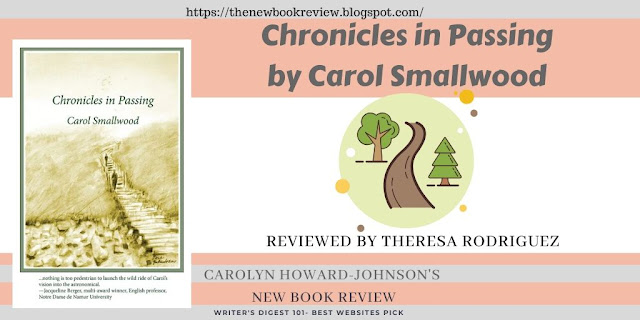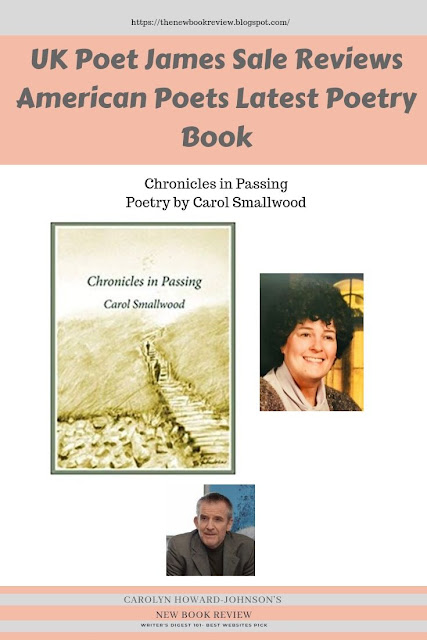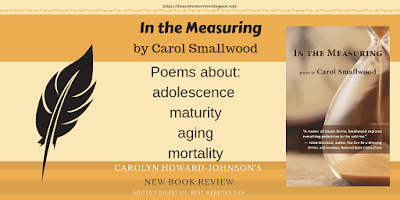Author: Carol Smallwood
Title: Chronicles in Passing
Publisher: Poetic Matrix Press, P.O. Box 1051, Lake Isabella, CA, 93240, 2019.
102 pp. $17.00.
Available on Amazon
The thing that struck me most strongly upon reading Carol Smallwood's Chronicles in Passing is the complete command of classical forms: the Rondeau, the Cinquain, the Pantoum, the Triolet, the Vianelle, and the Sestina. Smallwood displays fine technical mastery while uniquely using classical forms to frame her focus on the mundane and commonplace. Her writing flows with ease within the structure and rhyming of the classical forms. One can clearly see, as Smallwood mentions in her Introduction, that she “finds writing in formal style enjoyable” by “giving readers something extra,” “like presenting a box wrapped in a special paper with a bow.”
What I could also appreciate is that she does not limit herself only to formal or classical verse but recognizes that “there are times... when words in free verse are better in conveying the intended message,” in her endeavor to “try what fits.” I was glad to see free verse that did “fit” the intended topics very well.
Smallwood does indeed write about the mundane and commonplace, but her treatment of these topics is anything but mundane and commonplace. She manages to deftly take the mundane and transform it into the sublime. She gives weight and dignity to topics of life that might normally be overlooked. Blue jeans, the supermarket, clothes on a clothesline, a car wash, store flyers, homemade quilts and clothing, ballroom dancing, grocery shopping, going to a restaurant, dirt roads, spools of thread, clothing fashion, and the color pink-- none of these topics escapes Smallwood's decisive treatment. It causes one to be mindful of some of the ordinary things of life, things that can be shaped into works of great beauty, especially by the mind and pen of a skilled poet. It has given me an appreciation of our common world in a way I had not had before reading this volume. It has taught me to seek out the simple things and find the poetry in them. Smallwood most definitely has done this, in great measure!
I also enjoyed her sense of imagery and description which can be found throughout the volume. For instance, in one of my favorites “A Hardcover Book,” Smallwood talks about being perceived as some kind of anachronism by carrying around a hardcover book as opposed to “a small electronic tool,” as “quite the dinosaur, out of touch and even speckled with mold” (8). In her free verse “The Place of the Cure of the Soul,” Smallwood describes “something about the feel of books, the crackle of newspapers, smell of magazines and in owning them” (14). In her Vianelle “Counting Backwards,” she shares how
“...the chatter near Christmas Day
was irritating, but told it was just feminine hormone delay
and before long it would be better so wisely didn't reply when addressed” (17).
In “The Hovering,” deities are “defined in other cultures as weavers of destiny upon a tapestry loom” (19). In her Sestina “A Regular” we are given a lovely image of salt on a tray:
“... I noticed its salt sprinkles made a vast night sky full of wonder
and understand why our ancestors made stories of constellations” (26).
In “There Were Only,” she describes “gentle rain reinforcing the nose as the most elemental of the senses” and poignantly thinks of “computers blinking in the empty library like solitary lighthouses” (32).
My favorite, however, is the vianelle “Our Unconscious Censor,”where the subject of writing down dreams upon waking produces some excellent imagery, where one can “train” to write down dreams as soon as you wake:
“and confront the subterranean fear as if a waiting rattlesnake
coiled in a yawning cavern that's deeper, more terrifying than any hell”
and
“so get rid of the hoary, deep oozing fear making your tremble, shake:
but your built-in censor is a trench against shattering bombshells--”
Finally, she asks:
“Is one a coward not to go ahead and capture dreams, face at daybreak
once and for all-- end the fear-- what could be that awful to dispel?
One can train to write down dreams just as soon as you wake
yet is it best to let your built-in censor block when so much is at stake?” (70)
I also found her many of her choices of rhymes to be ingenious: I have never seen rhymes for “necessary,” “customary,” “shade vary,” “monetary,” “them airy,” and “arbitrary” in one poem before, but this is the quality of inventiveness we find in the Vianelle “An American Icon,” a poem about blue jeans (51). I was equally impressed with the rhyming of “myth” and “Monolith” in her Pantoum “The Pleiades” (16), and “diverged,” “surged,” “purged,” “converged,” “urged,” and “submerged” in her Vianelle “Two Roads” (68).
In reading her work in this volume I only occasionally see her inner life-- and the moments here and there are intriguing, and make me want her to reveal more. In “The New Galaxy,” she describes a date with “Mitchell,” where an evening at the opera reveals understated but deep feeling:
“...I remembered smiling at the attendant when he
asked 'Did you and your wife enjoy the performance'
because it meant we looked like we belonged together”
She goes on to share how she clutched the program of Aida, “proof that the night was real” and how
“...When Mitchell walked me to my
car in the darkness, his coat blew against me,
a benediction I knew had to be lasting. Would I ever
know the new galaxy the student had said with such
excitement had just been discovered?” (33)
I like this aspect of her writing, and wish there was more of it: tenderly rendered and touching. We do find more of this revelatory aspect in “A Matter of Nightmares,” where descriptions of Bob's nightmares are “terrible” and Alison's brother
“who'd returned from Nam:
unexpected sounds sent him diving under
any cover; certain smells made him shake,
his arms were infected trying to get rid of
“crawly leeches.”
She then describes Lily has having
“post-traumatic stress disorder first called
shell shock: that what went on behind white
picket fences was war.” (50)
I do like her understated treatment of the emotionally profound. I only wish there were more moments like this, as they intrigue and attract me. What more does this poet have inside, waiting to be revealed?
Carol Smallwood is to be praised for her skill, perspective, and philosophy over a wide poetic range. Hers is a unique set of senses, capturing sights, sounds, moments, and observations of the everyday world in such a manner that causes the reader to see what is all around him in a fresh, new way.
--Theresa Rodriguez is the author of Jesus and Eros: Sonnets, Poems and Songs (Bardsinger Books, 2015), Sonnets(Bardsinger Books, 2019) and Longer Thoughts (Shanti Arts, 2020).
MORE ABOUT THE BLOGGER, THIS BLOG, AND ITS BENEFITS FOR WRITERS
 The New Book Review is blogged by Carolyn Howard-Johnson, author of the multi award-winning HowToDoItFrugally series of books for writers. Of particular interest to readers of this blog is her most recent How to Get Great Book Reviews Frugally and Ethically (http://bit.ly/GreatBkReviews ) that covers 325 jam-packed pages covering everything from Amazon Vine to writing reviews for profit and promotion. Reviewers will have a special interest in the chapter on how to make reviewing pay, either as way to market their own books or as a career path--ethically!
The New Book Review is blogged by Carolyn Howard-Johnson, author of the multi award-winning HowToDoItFrugally series of books for writers. Of particular interest to readers of this blog is her most recent How to Get Great Book Reviews Frugally and Ethically (http://bit.ly/GreatBkReviews ) that covers 325 jam-packed pages covering everything from Amazon Vine to writing reviews for profit and promotion. Reviewers will have a special interest in the chapter on how to make reviewing pay, either as way to market their own books or as a career path--ethically!This blog is a free service offered to those who want to encourage the reading of books they love. That includes authors who want to share their favorite reviews, reviewers who'd like to see their reviews get more exposure, and readers who want to shout out praise of books they've read. Please see submission guidelines on the left of this page. Reviews and essays are indexed by genre, reviewer names, and review sites. Writers will find the search engine handy for gleaning the names of small publishers. Find other writer-related blogs at Sharing with Writers and The Frugal, Smart and Tuned-In Editor.
Note: Participating authors and their publishers may request the social sharing image by Carolyn Wilhelm at no charge. Please contact the designer at: cwilhelm (at) thewiseowlfactory (dot) com. Provide the name of the book being reviewed and--if an image or headshot of the author --isn't already part of the badge, include it as an attachment. Wilhelm will send you the badge to use in your own Internet marketing. Give Wilhelm the link to this post, too.









